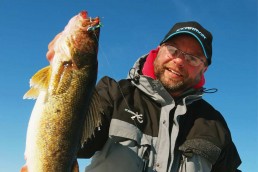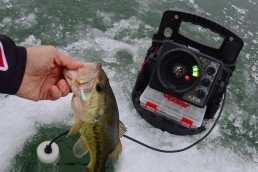Use both Live and Soft Baits When Ice Fishing
SHARE THIS POST
Walk the aisles of your favorite tackle store, and you can’t help but note the large array of packaged softbaits hanging from the pegs, as well containers of gooey lures and scent additives on the shelves. Many anglers feel these newfangled lures have replaced all need for live bait. However, use both live and soft baits when ice fishing.
Could that be true?
Understanding softbait
Softbaits have morphed to become more life-like than ever over their soft-plastic predecessors. Notice the difference in names: softbaits vs. soft plastics. What’s the difference?
As name the soft plastic states, these less-pliable lures of yesteryear were made of plastic; they were stiff and smelled just like what they were made of. Not the feel and flavor of something most fish want to eat.
Now, I’m not saying the soft plastic lures didn’t work back in the day. But they were used more for bulking up a lure’s profile when fishing at a fast pace.
Today’s softbaits, on the other hand, have little to no plastic in them at all; the materials they are made of are ultra-soft, and easily bond to whatever scent is infused into them. Some are made of natural, biodegradable material, and are more lifelike in shape and color than ever before. You can use them the same way as the old-fashioned soft plastics, to bulk up a lure, or use them plain Jane like you would live bait. They are that versatile.
A place for everything
While modern-day softbaits definitely have their place when ice fishing, so does live bait. Past Ice-Fishing Vacation Schools taught by my pro staff and myself provide some good examples.
Like last season, our upcoming ice-fishing schools will be held on Michigan’s Houghton Lake, Mullet Lake and Lake Huron’s Saginaw Bay. From each and every one of those waterways, students and staff alike caught several different species last year, both on live bait and softbaits.
Each of the three days on ice during the school, I’d power up my StrikeMaster power auger and bore up to twenty holes over an area I was going to fish. I’d then check the depth under each hole with my Lowrance sonar, to see which ones were nearest the breaklines I had found while using a Navionics mapping program in my GPS. Then, I’d set up a tip-up in that hole.
Because tip-ups are used as a deadsticking device (lure/bait sitting motionless, without jigging), they are best suited for live bait applications. In the case of setting my tip-up for walleyes during the schools, I used a large, lively shiner minnow of at least 3 inches in length.
The Setup
My tip-up rig consists of a Berkley ball-bearing swivel tied to the main line, and a 2-foot leader of 10-pound-test Berkley fluorocarbon leader. To the end of that, I use a thin-wired, size 10 red, Bleeding Bait Daiichi treble hook, and pinch a small split-shot on the fluorocarbon about a foot above that. (Tip: When using split shot on a tip-up, use just enough shot to keep a lively minnow in its place, but not so much that, when a fish grabs the minnow and trips the spool, the weight falls too quickly. A walleye, for example, which feels the sudden tug as the weight plummets and makes the line suddenly taut, will spit out even the most appetizing minnow in an instant when this happens.)
Are you enjoying this post?
You can be among the first to get the latest info on where to go, what to use and how to use it!
And when fishing a live minnow under a tip-up, I just nip one point of the thin-wire hook just under the dorsal fin, making sure not to go too deep and prick the spine; that will render the minnow motionless, defeating the purpose of using live bait in the first place.
In short: Any time I am using a rig that I am not adding action to by jigging—be it a tip-up or a deadstick rod—I use live bait, as it will create action of its own, be it a minnow, wiggler, grub.
The ups and downs
When jigging, the great bait debate of live verses fake bait can go either way. More so than not, I prefer softbaits when jigging, and here’s why: I can hope hole-to-hole much easier with softbait, as it stays on the hook better, and I can easily change out the style and size of softbait to best match the lure I’m am using.
Hole-hopping can be the death of even the liveliest live bait. As you take the bait out of the water, the extreme cold will instantly freeze it, and it will become more lethargic the more you move. Also, depending on the lure you are using, too large of a bait could impede the action of your lure.
By far the best softbait on the market I have found for ice fishing is Berkley Gulp. This softbait stays pliable in cold conditions, comes in several different shapes and sizes, and has a scent that attracts fish of all species. And with the ice angler in mind, Berkley developed a few different softbaits in smaller shapes that won’t impede the action of lures such as Rapala Jigging Raps, Slab Raps and Northland’s new Glo-Shot Jig and UV Forage Minnow Jig—all some of my favorite go-to lures.
In the Gulp line, and made just for ice anglers, are their tiny 1-inch Minnows, Alive Waxies and Ice Fish Fry. All have a small profile that won’t ruin the action of your lure, yet all have the scent of larger Gulp softbaits.
One or the other? How ‘bout both?
When it comes to ice fishing, there’s a place for both live bait and soft plastics.
When using a line that just sets there on its own, I prefer the liveliest of live bait and let it work its magic. But when I’m the one giving the action to my lure, I often prefer modern-day softbaits over the real thing.
Become a MidWest Outdoors Insider here!
MWO
SHARE THIS POST
Did you enjoy this post?
You can be among the first to get the latest info on where to go, what to use and how to use it!
Mark Martin
Mark Martin is a professional walleye tournament angler and instructor with the Ice Fishing School/Vacation series. For more information, check out his website at markmartins.net or fishingvacationschool.com.



